PAGE 1/2
Go to page 2
Chrysler
manufactured most of the large hatch M4A3(76) Shermans. It
produced 4017 M4A3(76)W from March 1944
to April 1945.
Production
Order T-9872/1 : 238 M4A3(76)W with VVSS : Serial Number 43528 / USA
3099762 through S/N 43765 / USA 3099999
Production
Order T-9872/2 : 462 M4A3(76)W with VVSS :
Serial Number 43766 / USA 30100000 through S/N 44227 / USA 30100461
Production
Order T-10151 : 671 M4A3(76)W with VVSS and 2 M4A3(76)W with HVSS :
Serial Number 44808 / USA 30101042 through S/N 45480 / USA 30101714
Production
Order T-10888/2 : 29 M4A3(76)W with VVSS and 824 M4A3(76)W with HVSS :
Serial Number 59719 / USA 3031582 through S/N 60571 / USA 3032434
Production
Order T-11168 : 1466 M4A3(76)W with HVSS :
Serial Number 60572 / USA 30113594 through S/N 62037 / USA 30115059
Production
Order T-14596/1 : 200 M4A3(76)W with HVSS :
Serial Number 67501 / USA 30123237 through S/N 67770 / USA 30123436
Production
Order T-14596/2 : 125 M4A3(76)W with HVSS :
Serial Number 72767 / USA 30136599 through S/N 72891 / USA 30136723
Fisher also manufactured some M4A3(76)W from September to December 1944.
Production
Order T-11315/2 : 525 M4A3(76)W with
VVSS :
Serial Number 62860 / USA 30115882 through S/N 63384 / USA 30116406
 The evolution of the M4A3(76)
started in early 1942 when the Ford Motor Company was contracted to manufacture
Medium Tanks powered by an in house designed 500 HP V8 engine. Since the engine
was new and untested, M4A3s initially served as training tanks in the US,
giving the company the opportunity to "iron out the bugs." In
comparison tests, the Ford GAA engine was found to be superior to the other
tank power plants, and in June 1943, it was declared "suitable for
overseas supply." It was further decided that production of M4A3s would be
reserved for US troops, both at home and abroad. While Ford left the Sherman
program in September 1943, it continued to supply engines to Chrysler and
Fisher Body for the 1944/45 production of M4A3s and M26s. During WW II, Ford's
Lincoln plant (above) produced 26,954 V8 tank engines.
The evolution of the M4A3(76)
started in early 1942 when the Ford Motor Company was contracted to manufacture
Medium Tanks powered by an in house designed 500 HP V8 engine. Since the engine
was new and untested, M4A3s initially served as training tanks in the US,
giving the company the opportunity to "iron out the bugs." In
comparison tests, the Ford GAA engine was found to be superior to the other
tank power plants, and in June 1943, it was declared "suitable for
overseas supply." It was further decided that production of M4A3s would be
reserved for US troops, both at home and abroad. While Ford left the Sherman
program in September 1943, it continued to supply engines to Chrysler and
Fisher Body for the 1944/45 production of M4A3s and M26s. During WW II, Ford's
Lincoln plant (above) produced 26,954 V8 tank engines.

 Click on the picture for larger size
Click on the picture for larger size
In August 1942, a few months
after Shermans began rolling off the assembly lines, the Ordnance Department
began testing the feasibility of mounting a 76 mm gun in the standard D50878
turret (above left). The intention was to produce 1000 76mm armed Medium Tanks
by the end of the year. Ultimately, the project was cancelled because it was
determined that the small turret was unsuitable. In the meantime, development
work was initiated on new Medium Tank designs known collectively as the T20
series. The T23, which mounted a 76mm gun in a larger turret, was never
standardized due to various technical problems (above right). However, since
the 69 inch diameter turret ring was the same as the Sherman's, the T23's 76mm
turret was easily adapted for use on the late 1943 revision of the M4 series.
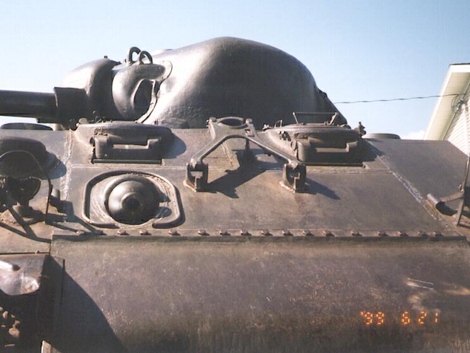 The original design of the
welded hull Sherman featured a rather elaborate glacis made up of armor plate
combined with various cast or "fabricated" components such as the
drivers' hoods. The photo above shows an October, 1942 production Ford built
M4A3(75), and provides an idea of one of the early glacis configurations. Ballistic
tests revealed the inherent weakness of the numerous weld joints and
protrusions. In March 1943 the Armor Branch determined "that these
weaknesses cannot be substantially eliminated by changes in the present
designs."
The original design of the
welded hull Sherman featured a rather elaborate glacis made up of armor plate
combined with various cast or "fabricated" components such as the
drivers' hoods. The photo above shows an October, 1942 production Ford built
M4A3(75), and provides an idea of one of the early glacis configurations. Ballistic
tests revealed the inherent weakness of the numerous weld joints and
protrusions. In March 1943 the Armor Branch determined "that these
weaknesses cannot be substantially eliminated by changes in the present
designs."

 Click on the picture for larger size
Click on the picture for larger size
In the meantime, in February
1943, the Army Medical Research Lab had concluded that the original drivers'
hatches were too small, and were the cause of numerous injuries, particularly
when crew members attempted to enter or exit their tanks in a hurry. Larger
hatch dimensions were submitted, but it was found that "increased size not
possible of application to present hull design." Thus, development work
was begun to reconfigure the front of the Sherman.
Chrysler Corporation submitted
a cast front design that addressed the deficiencies, and in June 1943, the
Ordnance Department approved of making all subsequent welded hull Shermans in
the so called "Composite" configuration as shown above left. However,
in that same month, Fisher Body submitted an alternate large hatch design based
on the M10 Tank Destroyer that they had developed in early 1942. It featured a
single 2 1/2 inch glacis plate that was mounted at a 47 degree angle, so that
the drivers' hatches could be repositioned in the roof of the hull. The
"Fisher front end" was found to be superior to the Chrysler Composite
concept, and became the basis for the "ultimate" or "second
generation" series of welded hull Shermans.
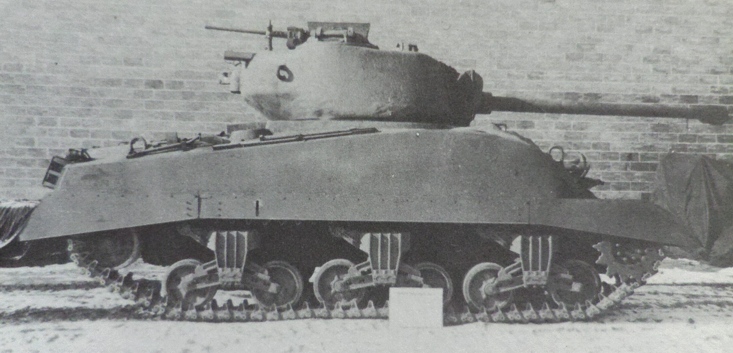
Above is shown the M4A3(76)
pilot model, USA 3054892, photographed at Chrysler in early 1944. The
Registration Number indicates that this tank was built by Ford as a small hatch
M4A3(75) in September, 1943. One can see that a large hatch front casting was
retrofitted to this particular prototype, reflecting the very brief competition
between the Chrysler and Fisher design concepts during development of the
"second generation" series of welded hull Shermans. Of course,
production M4A3(76)s would feature the "Fisher front end" as
explained above. Note that the pilot's turret was fitted with the less complex,
original version of the canvas mantlet cover. This suggests that it was
intended to equip 76mm turrets with a mantlet cover from the start. However, we
suspect that unresolved issues about the final design of the cover may have
delayed its introduction for nearly a year.
 The official nomenclature for our subject, as seen on dataplates
(inset), is "Tank, Medium, M4A3, 76MM Gun, Wet." "Wet" was shorthand for
"wet stowage." Thirteen five round ammunition racks were located on the
floor of the hull below the turret. Each five round rack had 3 sealed
chambers that were filled with a liquid "quenching solution." It was
thought that if an ammo rack was penetrated, the "quenching solution"
would be dispersed, and at least slow the progress of an ammunition fire
in order to give the crew a few more seconds to escape. For the tests,
the first solution tried was plain water. The second was water mixed
with ethylene glycol to prevent freezing. This was "suspected of being
inflammable" and a third solution "ethyl sodium potassium phosphate"
known as "Ammudamp" was substituted. Above, several of the racks are
shown in place. We've circled the filler plugs of the liquid chambers,
including the one for the six round ready rack mounted on the turret
basket floor. Some of the men involved in the wet stowage program
reported that the results of the tests "cast[s] doubt on the utility of
water protection...it is recommended that we fully investigate its
effectiveness, conducting tests if necessary to determine if it can be
eliminated. While a large number of people feel that is has no real
effect, Col. Cox says it has a definite morale effect on the crews." It
was noted that enclosing the bins in armor and relocating them to better
protected positions on the floor of the hull (as the British had
requested as early as June 1942) were the effective parts of the wet
stowage modification. They also mentioned that tankers wanted to carry
as much ammo as possible, and the inclusion of the liquid containers
came at the expense of an additional 10 to 12 rounds.
The official nomenclature for our subject, as seen on dataplates
(inset), is "Tank, Medium, M4A3, 76MM Gun, Wet." "Wet" was shorthand for
"wet stowage." Thirteen five round ammunition racks were located on the
floor of the hull below the turret. Each five round rack had 3 sealed
chambers that were filled with a liquid "quenching solution." It was
thought that if an ammo rack was penetrated, the "quenching solution"
would be dispersed, and at least slow the progress of an ammunition fire
in order to give the crew a few more seconds to escape. For the tests,
the first solution tried was plain water. The second was water mixed
with ethylene glycol to prevent freezing. This was "suspected of being
inflammable" and a third solution "ethyl sodium potassium phosphate"
known as "Ammudamp" was substituted. Above, several of the racks are
shown in place. We've circled the filler plugs of the liquid chambers,
including the one for the six round ready rack mounted on the turret
basket floor. Some of the men involved in the wet stowage program
reported that the results of the tests "cast[s] doubt on the utility of
water protection...it is recommended that we fully investigate its
effectiveness, conducting tests if necessary to determine if it can be
eliminated. While a large number of people feel that is has no real
effect, Col. Cox says it has a definite morale effect on the crews." It
was noted that enclosing the bins in armor and relocating them to better
protected positions on the floor of the hull (as the British had
requested as early as June 1942) were the effective parts of the wet
stowage modification. They also mentioned that tankers wanted to carry
as much ammo as possible, and the inclusion of the liquid containers
came at the expense of an additional 10 to 12 rounds.
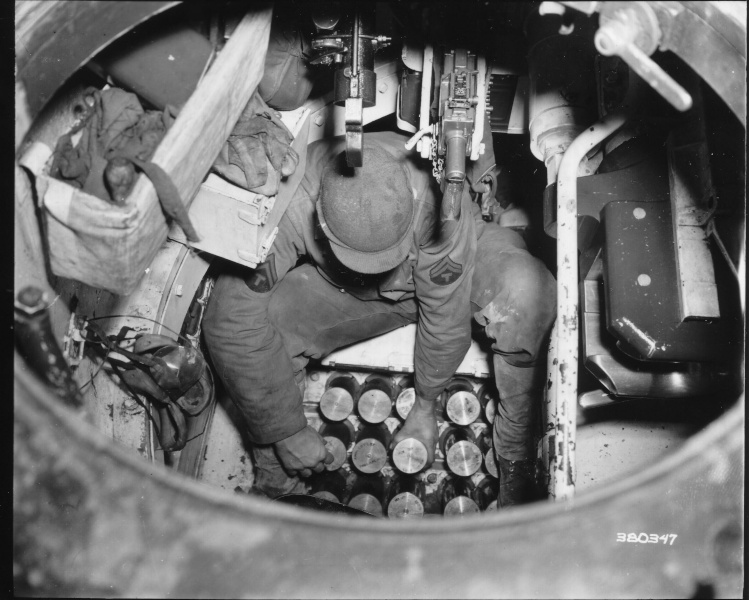
This Signal Corps photo is
captioned, "Tec 5 Benny G. Smith of Hartown, Ga., a member of a tank
crew, checks up on his supply of ammunition ...Welsfrang, [sic]
Luxembourg...20 Nov. 1944" It was taken through the round loader's
hatch of the original 76mm turret used on the Sherman, sometimes
referred to as the "T23 turret." It provides an idea of the cramped
conditions under which the loader had to work. Note how the handles of
the smoke mortar and coaxial .30 caliber guns are inches from his head.
The rounds are positioned on an angle, and a couple of the wet stowage
plugs are visible. Based on the location, Welfrange, and the date, we
suspect that T/5 Smith served with C Company, 774th Tank Battalion, and
that the Sherman was an M4A3(76). As a matter of minutia, we would
observe that other photos and diagrams show the 76mm rounds stowed tip
up.

In order to provide the loader
with easier access to the ammunition, the turret basket of the 76mm Sherman was
essentially cut in half. The view above was filmed at the 725th Ordnance Depot
in Korea in May 1951. One can see that the turret basket floor was reduced to a
little less than a half round shape. The six round ready rack (1) can be seen
to overhang the turret basket floor by a few inches. It is to be noted that the
M4A3(75)W retained a full turret basket floor that had ammunition access
hatches. Howitzer Shermans were NOT "wet stowage," and some of the
ammunition continued to be stowed "up high" on the sponsons, as on
the original Sherman design. As an aside, we would point
out that maintenance personnel were instructed NOT to use the gun mantlet's
lifting rings to hoist the turret, such as shown in the scene above, because it
could result in misalignment or other damage to the gun.

Chrysler began manufacturing
the M4A3(76) in March 1944. Most of the first 4 months' production was
scheduled for automatic shipment to Europe. The tanks were processed at US
Depots, and delivered to ports on the East Coast when completed. The first
allotment of 48 M4A3(76)s, marked with the shipping code "GLUE," was
"afloat" by the middle of June. "GLUE," which can be seen
in some period photos and on a few surviving tanks, is described as Zone II for
the receipt of cargo in the UK. It "included the southern portions of
England and Wales, and the ports of the Bristol Channel and Plymouth,
Southampton and London." In the early stages of the Normandy campaign, the
tanks continued to be shipped to GLUE, where they were transferred to LSTs, and
subsequently delivered over the beaches in Normandy. When port facilities, such
as Cherbourg, became available on the Continent, the tanks were shipped direct.
Above shows Serial Number 44220, a June 1944 production unit on display in
Germany. Unlike most surviving Shermans, this tank is in close to "as
built" configuration, although there is evidence that it was retrofitted
with a bulldozer blade. We would guess 44220 served with the US Army during WW
II, and may have been a battle casualty. "Paint archeology" has
revealed what appears to be the original "GLUE" shipping code, as
shown in the inset.
 Click on the picture for larger size
Click on the picture for larger size
The scene above was filmed in
La Cambe on the Normandy coast on August 12, 1944. The 948th Ordnance Motor
Vehicle Distribution Company appears to have completed the process of preparing
these tanks for issue. The shipping sealant has been removed, although some
remaining traces of it can be seen as dark spots. Chalked notes on the foremost
Sherman indicate that the radio and "artillery" have been checked, and
gasoline has been added. Chrysler shipped these tanks
with the USA Number painted on the rear sides rather small in blue drab. In mid 1943, a directive
was issued that the number was to be painted on larger and in white. Directives
were not always heeded, but most of the US Shermans that took part in the
Normandy Campaign can be seen with the larger, white Registration Numbers. We
recorded the M4A3(76) in the foreground as USA 3099839, indicating April 1944
acceptance. The USA Number is the brightest thing on these tanks, so we would
guess it was painted on by the 948th. Some items of interest are the extra
lifting ring (1) and the absence of the machine gun fittings (2) on the turret,
the "early" position of the forward cable clamp (3), and the siren
(4).
 Click on the picture for larger size
Click on the picture for larger size
In Italy, Company A of the
13th Tank Battalion, 1st Armored Division was the one of the first units to
receive the new tanks, and the scene above was filmed on a range near Pisa,
August 19, 1944. The problem of smoke obscuration is evident, and it was thought
that a muzzle brake would provide a remedy. However, tests had shown that, by
itself the muzzle brake was insufficient, and "long primer"
ammunition was developed at the same time. This combination helped to cut down
the smoke and blast effects. Company A's guns can be seen to be the second
version of the 76mm - the M1A1C. These were "threaded" to accept
muzzle brakes when they became available in late 1944. In the meantime the
threads were protected with a "collar." These tanks feature
"extra lifting ring" turrets. Of note is that the commander's cupolas
are not in their factory installed positions, but have been reoriented so that
the hatches open further to the rear. In some correspondence from the
Mediteranean Theater of Operations to the Ordnance Department, it was suggested
that this should be the standard orientation of the cupola.
 Click on the picture for larger size
While Ford engined Shermans
were reserved for US Army use, the combat debut of the M4A3(76) may have been
with the French 2nd Armored Division. The Division was attached to
the US Third Army, and received a few of the first M4A3(76)s as replacements in
late August. "Champagne," Number 55, served with the 3rd Squadron of the
12th Régiment de Chasseurs d’Afrique. On August 25, 1944, during the battle for
Paris, her crew was credited with firing the "kill shot" that knocked
out a Panther in the Place de la Concorde. In general, the French painted out
the US Army Registration Numbers of their Lend Lease vehicles, and applied their
own "matricule" numbers. However, in the crew snapshot above, one can
see that Champagne "still" had the USA Number painted on in the same
manner as the tanks seen in the August 12th La Cambe photo. "3099828
S" was the 67th M4A3(76) made by Chrysler, and would have been accepted in
April, 1944. (The "S" often seen at the end of USA Numbers is
frequently mistaken for a "5," but it signifies that the vehicle was
equipped with a Radio Interference Suppression System.). Photo courtesy of Musée de la libération-Jean Moulin-Ville de Paris.
Click on the picture for larger size
While Ford engined Shermans
were reserved for US Army use, the combat debut of the M4A3(76) may have been
with the French 2nd Armored Division. The Division was attached to
the US Third Army, and received a few of the first M4A3(76)s as replacements in
late August. "Champagne," Number 55, served with the 3rd Squadron of the
12th Régiment de Chasseurs d’Afrique. On August 25, 1944, during the battle for
Paris, her crew was credited with firing the "kill shot" that knocked
out a Panther in the Place de la Concorde. In general, the French painted out
the US Army Registration Numbers of their Lend Lease vehicles, and applied their
own "matricule" numbers. However, in the crew snapshot above, one can
see that Champagne "still" had the USA Number painted on in the same
manner as the tanks seen in the August 12th La Cambe photo. "3099828
S" was the 67th M4A3(76) made by Chrysler, and would have been accepted in
April, 1944. (The "S" often seen at the end of USA Numbers is
frequently mistaken for a "5," but it signifies that the vehicle was
equipped with a Radio Interference Suppression System.). Photo courtesy of Musée de la libération-Jean Moulin-Ville de Paris.
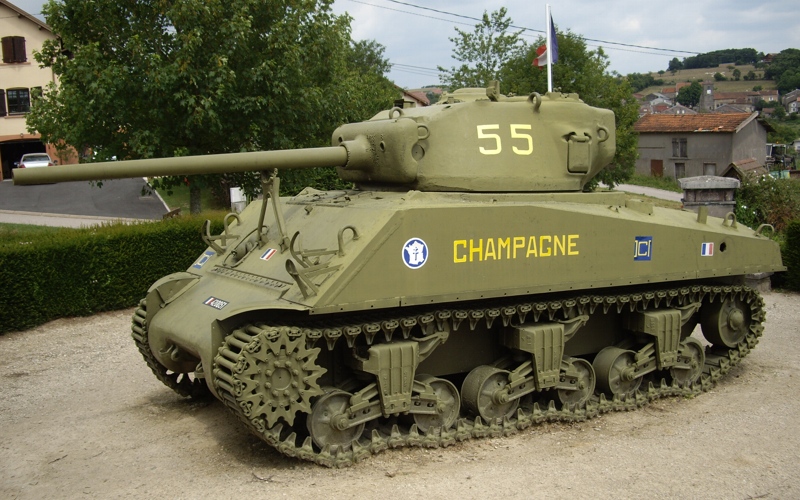 The M4A3(76) on display as a
monument in Ville-sur-Illon, France has the serial number 43594 stamped on the
rear towing lugs. There is a mathematical correlation between the Ordnance
Serial Number and the USA Number of Shermans, and 43594 is an exact match to
USA 3099828, confirming that this is the "real" Champagne. She was
knocked out on September 13, 1944, not far from where she now stands. The crew
managed to escape as the tank caught fire. In the photo above, it can be seen
that the intensity of the fire melted most of the rubber from the tracks and
road wheels. Champagne was one of the few M4A3(76)s to come equipped with the
"unthreaded" M1A1 gun. Pressed Steel Car began M4A1(76) production in
January 1944, two months before Chrysler began manufacture of the M4A3(76). An
Ordnance Department document states that "All Medium Tanks M4 series (76mm
gun) since first 385 produced have been equipped with threaded gun tubes."
Thus, the M1A1 is more commonly seen on early M4A1(76)s. Our counting heads
method suggests that Chrysler was distributed less than 100 M1A1s, and
completed the transition to the threaded M1A1C guns in April 1944, the same month
that Champagne was built.
The M4A3(76) on display as a
monument in Ville-sur-Illon, France has the serial number 43594 stamped on the
rear towing lugs. There is a mathematical correlation between the Ordnance
Serial Number and the USA Number of Shermans, and 43594 is an exact match to
USA 3099828, confirming that this is the "real" Champagne. She was
knocked out on September 13, 1944, not far from where she now stands. The crew
managed to escape as the tank caught fire. In the photo above, it can be seen
that the intensity of the fire melted most of the rubber from the tracks and
road wheels. Champagne was one of the few M4A3(76)s to come equipped with the
"unthreaded" M1A1 gun. Pressed Steel Car began M4A1(76) production in
January 1944, two months before Chrysler began manufacture of the M4A3(76). An
Ordnance Department document states that "All Medium Tanks M4 series (76mm
gun) since first 385 produced have been equipped with threaded gun tubes."
Thus, the M1A1 is more commonly seen on early M4A1(76)s. Our counting heads
method suggests that Chrysler was distributed less than 100 M1A1s, and
completed the transition to the threaded M1A1C guns in April 1944, the same month
that Champagne was built.

 An
anomaly seen on many of the early Chrysler M4A3(76)s is the presence of
what is informally referred to as "the extra lifting ring" in front of the
loader's hatch. This is a vestige of Chrysler's abortive T23 program.
The T23 featured a boom for raising the power pack, and the extra
lifting ring served to support part of the boom's rigging. While the
extra lifting ring did no harm on the Sherman (crews like to hang stuff
on it), it was eliminated from subsequent turret molds. As best as can
be determined, about 500 "XLR" turrets were mixed in with the first four
month's M4A3(76) production at Chrysler. Chrysler was supplied with
turrets made by American Steel Foundries & Continental Steel, and
their casting logos are the only ones that have been seen on surviving
"XLR" turrets. At left, the extra lifting ring as seen on the turret of
an actual T23 Medium Tank, and the same thing at right on Champagne.
Note that the turret on the T23 has the caster's logo of
Continental-Hubbard (H in a C) (1) while Champagne has an American Steel
Foundries-Granite City (G in an octagon) logo (2). As a matter of
minutia, we would note that Continental turret castings have been
observed with "hard edges" (arrow) on the sides at the bottom, while
ASF turret molds have "soft edges" such as seen on Champagne.
An
anomaly seen on many of the early Chrysler M4A3(76)s is the presence of
what is informally referred to as "the extra lifting ring" in front of the
loader's hatch. This is a vestige of Chrysler's abortive T23 program.
The T23 featured a boom for raising the power pack, and the extra
lifting ring served to support part of the boom's rigging. While the
extra lifting ring did no harm on the Sherman (crews like to hang stuff
on it), it was eliminated from subsequent turret molds. As best as can
be determined, about 500 "XLR" turrets were mixed in with the first four
month's M4A3(76) production at Chrysler. Chrysler was supplied with
turrets made by American Steel Foundries & Continental Steel, and
their casting logos are the only ones that have been seen on surviving
"XLR" turrets. At left, the extra lifting ring as seen on the turret of
an actual T23 Medium Tank, and the same thing at right on Champagne.
Note that the turret on the T23 has the caster's logo of
Continental-Hubbard (H in a C) (1) while Champagne has an American Steel
Foundries-Granite City (G in an octagon) logo (2). As a matter of
minutia, we would note that Continental turret castings have been
observed with "hard edges" (arrow) on the sides at the bottom, while
ASF turret molds have "soft edges" such as seen on Champagne.
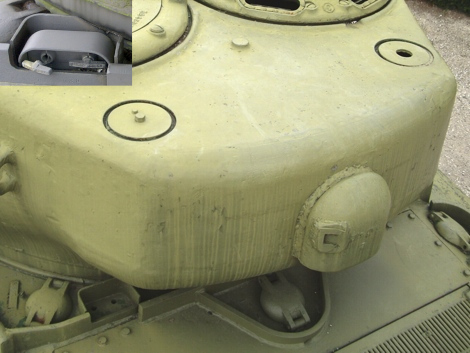
Unlike
the early M4A1(76)s, the turrets installed on Chrysler M4A3(76)s were
"up to spec" as regards the ventilator and the "standard" loader's split
hatch. However, period photos, such as the one taken at La Cambe, show
that some of the first Chryslers were "out of spec" as they were missing
the L-shape MG barrel stowage brackets on the turret rear. Note that on
Champagne, one can see "weld scars" on the ventilator where the machine
gun stowage pintle was once installed, but there is no evidence that
this tank ever had the L-shaped brackets. Also, observe that the
surround protecting the fire extinguisher housing is intact, that is, it
is the same height all around. A small number of surviving M4A3(76)s
are seen with a bit of the surround cut out (inset), most likely to
ensure that the turret didn't hit it. The evidence suggest that all 2nd
Generation Shermans were built with the surround intact, but that some
were cut out on M4A3(76)s, perhaps during post war rebuilds.

 The examination of surviving examples makes it obvious that, at some
point fairly early on, it was decided not to machine out and provide for
the forward antenna socket on the turret. The above photos show what local researchers believe to be a combat casualty of B Company,
2nd Tank Battalion, 9th Armored Division, knocked out on or about 17
December 1944, in Clervaux, Luxemburg. This tank has been on display at
the castle in Clervaux for many years and we recorded the serial number
from one of the rear tow lugs as 43911, indicating May 1944 production.
Note that "the extra lifting ring" has been eliminated from the
Continental-Hubbard, "hard edged" turret mold, and that there is only
the "ghost" of the former antenna socket, circled in red. The blanks
over the smoke mortar hole and other openings were no doubt added for
the display, but otherwise this tank, complete with shot gouges, appears
to be a true battle relic. The US Army’s Ordnance Maintenance personnel
had an excellent record of recovering or salvaging battlefield wrecks.
Tanks that had burned were considered unrecoverable and often left in
place. 43911 does not appear to have burned, so we wonder why she was
not recovered? Update: We were informed that in 2024 this Sherman was
refurbished and placed back on display in a covered setting at Clervaux
Castle. With thanks to André Flener.
The examination of surviving examples makes it obvious that, at some
point fairly early on, it was decided not to machine out and provide for
the forward antenna socket on the turret. The above photos show what local researchers believe to be a combat casualty of B Company,
2nd Tank Battalion, 9th Armored Division, knocked out on or about 17
December 1944, in Clervaux, Luxemburg. This tank has been on display at
the castle in Clervaux for many years and we recorded the serial number
from one of the rear tow lugs as 43911, indicating May 1944 production.
Note that "the extra lifting ring" has been eliminated from the
Continental-Hubbard, "hard edged" turret mold, and that there is only
the "ghost" of the former antenna socket, circled in red. The blanks
over the smoke mortar hole and other openings were no doubt added for
the display, but otherwise this tank, complete with shot gouges, appears
to be a true battle relic. The US Army’s Ordnance Maintenance personnel
had an excellent record of recovering or salvaging battlefield wrecks.
Tanks that had burned were considered unrecoverable and often left in
place. 43911 does not appear to have burned, so we wonder why she was
not recovered? Update: We were informed that in 2024 this Sherman was
refurbished and placed back on display in a covered setting at Clervaux
Castle. With thanks to André Flener.



The 2 inch smoke mortar was
standard at the beginning of M4A3(76)W production. At Chrysler, the mortar hole
was level with the armor at first, but later production units can be seen with
a protruding sleeve. A weatherproofing cap with retaining chain was finally
added in late 1944. Fisher Body appears to have installed the weatherproofing
cap on its entire run of 525 M4A3(76)s. In January, 1945 the Ordnance
Department ordered the elimination of the smoke mortar. It is thought that the
builders would have implemented this directive in the following months. Any
remaining turrets with the smoke mortar hole would have had it covered over or
filled in, and later turrets would have been “undrilled” for the smoke mortar.
Most surviving Shermans can be seen with the mortar hole blanked off or filled
in. This would have been done during the course of their post war service, or
as part of an early 1950’s remanufacture. Thus, an intact mortar fitting on a
surviving Sherman, such as Champagne, is a clue that “time stopped” for that
tank during World War II.


Small changes were
incorporated by Chrysler during the course of production. From the outset until
around August 1944, Chrysler M4A3(76)s had what the authors think of as the
"early" glacis pattern. This featured inboard hull lifting rings and
"long" bullet splashes in front of the drivers' auxiliary periscopes
(circled in red). The top edge of the glacis plate was neatly beveled.

 Chrysler transitioned to the "mid"
glacis pattern around August. The bullet splashes were shortened so
that they were only welded on directly in front of the auxiliary
periscopes. The top edge of the glacis plate was no longer beveled
flat, but was square cut, resulting in a sharp or peaked appearance as
seen above. The rear view mirrors appear to have been introduced at
about the same time as the mid glacis pattern. Photo on the far
right courtesy of Vladimir Yakubov.
Chrysler transitioned to the "mid"
glacis pattern around August. The bullet splashes were shortened so
that they were only welded on directly in front of the auxiliary
periscopes. The top edge of the glacis plate was no longer beveled
flat, but was square cut, resulting in a sharp or peaked appearance as
seen above. The rear view mirrors appear to have been introduced at
about the same time as the mid glacis pattern. Photo on the far
right courtesy of Vladimir Yakubov.

The "late" or
"final" glacis pattern was introduced by Chrysler around November
1944. It was identical to the mid pattern except that the hull lifting rings
were repositioned "outboard" to the edge of the glacis.
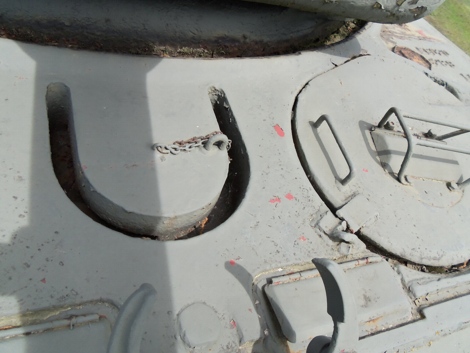
 The
U-shaped ventilator opening between the drivers' hatches was quite
wide, about 1 inch. Thus rain water and debris could easily fall into
the ductwork below it, and threaten damage to the blower motor. Based
on user feedback, a sheet metal cover with screen was introduced around
August, 1944. We have not found any evidence that modification kits for
the covers were shipped overseas during WW II, but have noted that many
surviving Shermans that obviously didn't have this item factory
installed, had it added later during postwar upgrades. The U bolt
that can be see on the uncovered example above held the padlocks for
the drivers' hatches. Based on questions from a few modelers, we would
suggest that "uncovered" should be the default configuration for model
companies attempting to recreate a 2nd Generation welded hull Sherman
with the early glacis pattern.
The
U-shaped ventilator opening between the drivers' hatches was quite
wide, about 1 inch. Thus rain water and debris could easily fall into
the ductwork below it, and threaten damage to the blower motor. Based
on user feedback, a sheet metal cover with screen was introduced around
August, 1944. We have not found any evidence that modification kits for
the covers were shipped overseas during WW II, but have noted that many
surviving Shermans that obviously didn't have this item factory
installed, had it added later during postwar upgrades. The U bolt
that can be see on the uncovered example above held the padlocks for
the drivers' hatches. Based on questions from a few modelers, we would
suggest that "uncovered" should be the default configuration for model
companies attempting to recreate a 2nd Generation welded hull Sherman
with the early glacis pattern.

 The earliest M4A3(76)s were
made with two small weep holes in the rear of the turret splash. It was found
that the small holes could become clogged with debris, causing water to back up
and foul the gasoline supply of the auxiliary generator, and/or cause a build
up of dirt in the turret bearing race. It was thought that a single, large hole
would alleviate these problems. This transition appears to have been made in
July 1944. Some of Chrysler’s early 105 Shermans can be seen to have the gap
(1) between the turret splash and the fuel cap bullet splash filled in by
welding. We have not seen any evidence of the “closed gap” on any Fisher or
Chrysler M4A3(76)s.
The earliest M4A3(76)s were
made with two small weep holes in the rear of the turret splash. It was found
that the small holes could become clogged with debris, causing water to back up
and foul the gasoline supply of the auxiliary generator, and/or cause a build
up of dirt in the turret bearing race. It was thought that a single, large hole
would alleviate these problems. This transition appears to have been made in
July 1944. Some of Chrysler’s early 105 Shermans can be seen to have the gap
(1) between the turret splash and the fuel cap bullet splash filled in by
welding. We have not seen any evidence of the “closed gap” on any Fisher or
Chrysler M4A3(76)s.


From the start of production
through about June 1944, Chrysler M4A3(76)s featured one-piece rear most engine
deck plates, as seen on Champagne in the photo on the left. Starting around
July, the rear plate was divided into two pieces to make it easier for crew
members to lift. The large, grated engine deck doors were heavy, and door
bumpers (item 1) were added to the "ultimate" M4A3 series. The
standard tool stowage arrangement can be seen above right on the restored
August 1944 production unit, formerly of the Littlefield Collection. Right side photo
courtesy of Chris Hughes.


Another early production clue
has to do with the location of the forward cable clamp (circled, above left).
Starting around July 1944, Chrysler installed the clamp more towards the front
of the tank (above right). We think of this as the “standard” position, since
it is seen on the vast majority of large hatch, welded hull Shermans. Note that
on all of its large hatch Shermans, except for a few of the first M4A2(75)s,
Fisher appears to have mounted the cable clamp in the "standard"
position from the start.

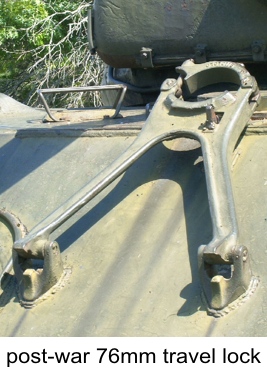 76mm and 105mm Shermans were
equipped with the same gun travel lock. It was about 4 inches taller than the
one used on 75mm tanks. Many surviving Shermans have been upgraded with a
single piece locking arm, but the less stable WW II configuration consisted of
a two "fingers" or "scissors jaw" configuration.
76mm and 105mm Shermans were
equipped with the same gun travel lock. It was about 4 inches taller than the
one used on 75mm tanks. Many surviving Shermans have been upgraded with a
single piece locking arm, but the less stable WW II configuration consisted of
a two "fingers" or "scissors jaw" configuration.
 During the course of their M3
Lee program, Chrysler designed the pressed metal type of bogie (1) and idler
wheels (3). They used them throughout production on their VVSS
equipped Shermans. Their distinctive drive sprocket (2) was also employed throughout,
including HVSS production. Both Chrysler and Fisher M4A3(76)VVSS Shermans were
equipped with upswept return roller arms (4) from the start of production.
Chrysler’s Kercheval plant in Detroit was tasked with assembling bogie units.
Anything with a date is valuable to our research, and one of Chrysler’s prime
suppliers of bogie bracket castings was the National Malleable and Steel
Castings Company, whose logo was an “N in a circle” (inset, from another M4A3(76)). They included a production
date on their bogie castings. In general, original component parts will predate
the acceptance of the tank by several months. So, for instance, we know by the
serial number that the M4A3(76) in Clervaux (shown above) was made in May of
1944, and it can be seen that most of its bogies are dated 2-44.
During the course of their M3
Lee program, Chrysler designed the pressed metal type of bogie (1) and idler
wheels (3). They used them throughout production on their VVSS
equipped Shermans. Their distinctive drive sprocket (2) was also employed throughout,
including HVSS production. Both Chrysler and Fisher M4A3(76)VVSS Shermans were
equipped with upswept return roller arms (4) from the start of production.
Chrysler’s Kercheval plant in Detroit was tasked with assembling bogie units.
Anything with a date is valuable to our research, and one of Chrysler’s prime
suppliers of bogie bracket castings was the National Malleable and Steel
Castings Company, whose logo was an “N in a circle” (inset, from another M4A3(76)). They included a production
date on their bogie castings. In general, original component parts will predate
the acceptance of the tank by several months. So, for instance, we know by the
serial number that the M4A3(76) in Clervaux (shown above) was made in May of
1944, and it can be seen that most of its bogies are dated 2-44.
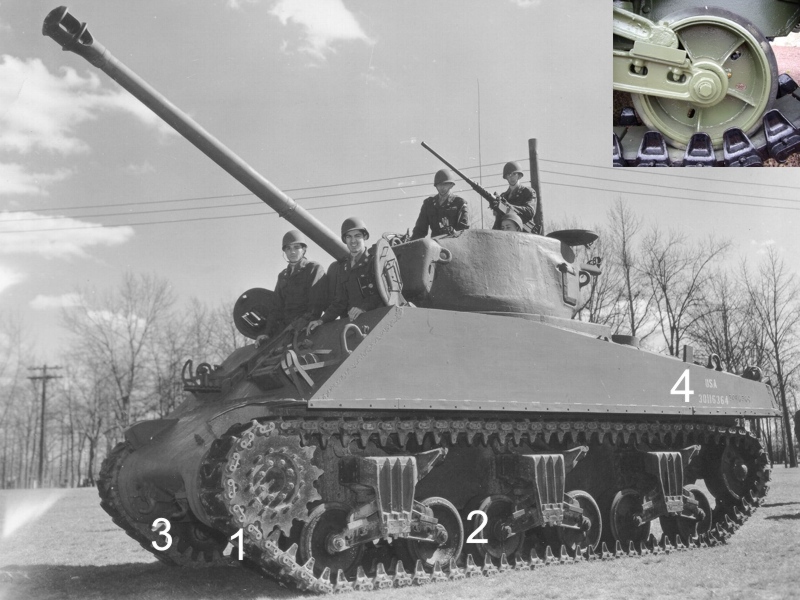 Click on
the photo for larger size
It is thought that all of the
525 M4A3(76)s manufactured by Fisher Body from September to December 1944 would
have featured Vertical Volute Spring Suspension and the late glacis pattern. We
estimate that Fisher completed the transition to the D7054366 turret with oval
loader's hatch, and the M1A2 gun with muzzle brake in October, 1944. The tank
pictured above can be seen to be USA 30116364, indicating December, 1944
acceptance. A couple of clues as to its Fisher (as opposed to Chrysler) origin
can be found in the "plain" drive sprocket (1), and the solid concave
road wheels (2). By mid 1944, two types of road wheels were prevalent on Fisher
VVSS Shermans - the solid, and the "welded spoke with small holes"
(inset). The improved T-shaped towing shackles (3) were introduced in October. A
close look at the USA Number (4) shows that it was also welded on. This was a
practice of the 1st Armored Division in Italy, and indeed their records
indicate that 30116364 was issued to the 13th Tank Battalion on April 1, 1945. The photo was taken at Ft. Monmouth,
New Jersey 3 years later on April 3, 1948. This
tank is what we informally call a "bring back." Most likely it would
have been retrofitted with HVSS during the remanufacture program of the early
1950s.
Click on
the photo for larger size
It is thought that all of the
525 M4A3(76)s manufactured by Fisher Body from September to December 1944 would
have featured Vertical Volute Spring Suspension and the late glacis pattern. We
estimate that Fisher completed the transition to the D7054366 turret with oval
loader's hatch, and the M1A2 gun with muzzle brake in October, 1944. The tank
pictured above can be seen to be USA 30116364, indicating December, 1944
acceptance. A couple of clues as to its Fisher (as opposed to Chrysler) origin
can be found in the "plain" drive sprocket (1), and the solid concave
road wheels (2). By mid 1944, two types of road wheels were prevalent on Fisher
VVSS Shermans - the solid, and the "welded spoke with small holes"
(inset). The improved T-shaped towing shackles (3) were introduced in October. A
close look at the USA Number (4) shows that it was also welded on. This was a
practice of the 1st Armored Division in Italy, and indeed their records
indicate that 30116364 was issued to the 13th Tank Battalion on April 1, 1945. The photo was taken at Ft. Monmouth,
New Jersey 3 years later on April 3, 1948. This
tank is what we informally call a "bring back." Most likely it would
have been retrofitted with HVSS during the remanufacture program of the early
1950s.
 Ordnance documents state that
the Muzzle Brake, M2 was standardized, and 300 had been produced by the end of
August 1944. Production was scheduled at the rate of 100 per day "until
requirements are met." Internal items were necessary, including a
counterweighted breech guard, to balance the 87 pound muzzle brake. US Armored
Forces in Europe began requesting muzzle brake modification kits and long
primer ammunition in early September, 1944. In general, priority for new items
was given to the tank manufacturers. Modification kits for Tank Depot and Field
installation were produced only after manufacturers' requirements were met. When
the Ordnance Department informed the ETO that Modification kits would not
become available until early 1945, the response was that this was "not
satisfactory. Urgent requirement exists." The ETO insisted on the
immediate air shipment of 3 stand alone muzzle brakes, and a further 600 by
fast water transport, with the note "counterweights can be added by Field
Modification." As it was, these items were shipped in late December, just
as the first M4A3(76)s with muzzle brakes and HVSS were distributed to troops
in Europe. We've reproduced a few pages of the Modification Work Order above. It
is dated July 25, 1945, not quite the "early 1945" availability that
Ordnance had given to the ETO. No doubt other factors were involved, but it is
likely that the diversion and shipment of the 603 muzzle brakes may have played
a role in the delayed release of the MWO.
Ordnance documents state that
the Muzzle Brake, M2 was standardized, and 300 had been produced by the end of
August 1944. Production was scheduled at the rate of 100 per day "until
requirements are met." Internal items were necessary, including a
counterweighted breech guard, to balance the 87 pound muzzle brake. US Armored
Forces in Europe began requesting muzzle brake modification kits and long
primer ammunition in early September, 1944. In general, priority for new items
was given to the tank manufacturers. Modification kits for Tank Depot and Field
installation were produced only after manufacturers' requirements were met. When
the Ordnance Department informed the ETO that Modification kits would not
become available until early 1945, the response was that this was "not
satisfactory. Urgent requirement exists." The ETO insisted on the
immediate air shipment of 3 stand alone muzzle brakes, and a further 600 by
fast water transport, with the note "counterweights can be added by Field
Modification." As it was, these items were shipped in late December, just
as the first M4A3(76)s with muzzle brakes and HVSS were distributed to troops
in Europe. We've reproduced a few pages of the Modification Work Order above. It
is dated July 25, 1945, not quite the "early 1945" availability that
Ordnance had given to the ETO. No doubt other factors were involved, but it is
likely that the diversion and shipment of the 603 muzzle brakes may have played
a role in the delayed release of the MWO.
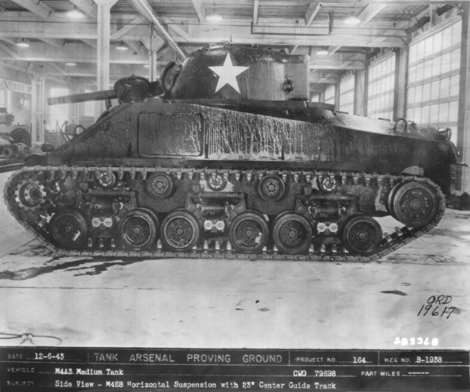
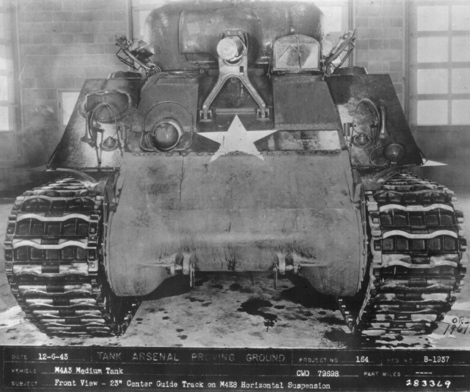 Click on
the photos for larger size
Click on
the photos for larger size
In the Summer of 1943, the
Chrysler Corporation began development of "horizontal volute spring
suspension and 23” center guided tracks for Medium Tank, M4 series." The
"E8" modification was an effort to improve the ride and increase the
mobility of the Sherman series. The photos above show one of the pilots, a
September 1943 Ford M4A3(75), at Chrysler's Tank Arsenal Proving Ground on
December 6, 1943. HVSS was released for production in April, 1944, and Chrysler
completed the transition to the manufacture of all HVSS Shermans in September. Fisher
Body and Pressed Steel Car completed the changeover on January 1, 1945. Fisher
produced 525 M4A3(76)s from September through December, 1944, and it is thought
that all of them were made with VVSS. Thus Chrysler was solely
responsible for series production of the M4A3(76) with HVSS.

The average shipping time of a
new tank from factory to combat troops was 4 to 5 months. The first M4A3(76)s
with HVSS appear to have been distributed at the end of December, 1944. For
instance on December 30, the 37th Tank Battalion, 4th Armored Division reported
that they had 5 "76mm - new suspension." The Signal Corps photo above
is datelined Bastogne, Belgium, January 8, 1945. The caption simply reads,
"Tanks of the 4th Armd Div ready for action in front lines." While
not the most informative shot, we have included it because it shows what may be
the earliest appearance of both HVSS and the muzzle brake in a combat theater. The
.50 caliber Machine Gun appears to be positioned pretty far forward and to the
left on the turret, suggesting that it may be the earlier D82081 turret, with
the MG mounted on the pintel of the loader's split hatch. Chrysler began
factory installation of the muzzle brake in October, and introduced the later
7054366 turret with oval loader's hatch in that same month. Due to the
transitional nature of the introduction of changes, some examples of earlier
turrets can be seen with guns with muzzles brakes, while some later turrets can
be seen without them.
 The Signal Corps shot a
"walk around" of USA 3031867, an October 1944 production
M4A3(76)HVSS. The design of the muzzle brake was "borrowed" from the
Germans, and in order to avoid friendly fire incidents, an effort was made to
alert Allied Troops to the presence of muzzle brakes on new production
Shermans. 3031867 was photographed on January 17, 1945 as it was being
processed for issue by the 98th Ordnance Heavy Maintenance Company (Tank) based
near Charmes in the Lorraine area of France. The stencil on the front (1) reads
"American Export Modification, November 6, 1944," indicating that
this tank was still at a US Tank Depot on that date. The original stars and
shipping code have been scrubbed out, but we suspect 3031867 came in through
the port of Marseilles, whose destination code was "LEGS." The newly
painted "stars in a circle" are much more commonly seen on tanks
processed by Ordnance units in Italy and southern France. The automobile style
horn (2) replaced the siren in production in the summer of 1944. The shipping
brackets (3) on the front and rear bogies were directed to be removed upon
final delivery. "Failure to remove this bracket when unloading the vehicle
from the freight car often results in damage to the tracks when operated over
rough terrain."
The Signal Corps shot a
"walk around" of USA 3031867, an October 1944 production
M4A3(76)HVSS. The design of the muzzle brake was "borrowed" from the
Germans, and in order to avoid friendly fire incidents, an effort was made to
alert Allied Troops to the presence of muzzle brakes on new production
Shermans. 3031867 was photographed on January 17, 1945 as it was being
processed for issue by the 98th Ordnance Heavy Maintenance Company (Tank) based
near Charmes in the Lorraine area of France. The stencil on the front (1) reads
"American Export Modification, November 6, 1944," indicating that
this tank was still at a US Tank Depot on that date. The original stars and
shipping code have been scrubbed out, but we suspect 3031867 came in through
the port of Marseilles, whose destination code was "LEGS." The newly
painted "stars in a circle" are much more commonly seen on tanks
processed by Ordnance units in Italy and southern France. The automobile style
horn (2) replaced the siren in production in the summer of 1944. The shipping
brackets (3) on the front and rear bogies were directed to be removed upon
final delivery. "Failure to remove this bracket when unloading the vehicle
from the freight car often results in damage to the tracks when operated over
rough terrain."

This photo of 3031867 provides
a good view of the mid glacis. Note the "sharpness" (1) of the square
cut upper edge, a characteristic of mid and late glacis plate patterns. The
extended smoke mortar (2) is simply taped over. While Fisher Body began to install
the smoke mortar cap with retaining chain to its Shermans in July 1944,
Chrysler doesn't appear to have added it until December, at about the same time
as the introduction of the fittings for the canvas mantlet cover. The T80
tracks (3) were considered greatly superior to Chrysler's original design T66
tracks. Internal correspondence mentions that Chrysler ran short of track, and
shipped some of its HVSS Shermans to depots without them. Fisher Body and
Pressed Steel Car were accumulating 23 inch tracks in anticipation of their
change over to HVSS, and they diverted some of their supplies to the depots, so
that the Chrysler tanks could be completed and shipped out.
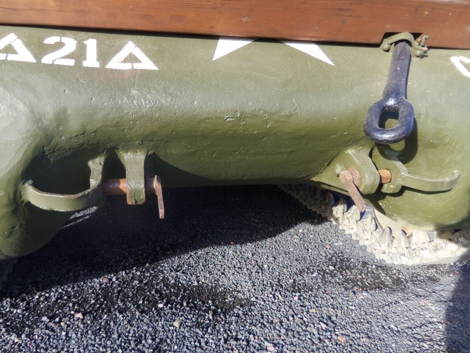

Second generation Shermans
started out with the quick release towing fixtures shown on the left. An
Ordnance Dept. "Report of Modifications Entering Production at
Facilities" states that the "Cross Bar Towing Hooks" were
installed on M4A3(76)s at the Detroit Tank Arsenal starting on December 12,
1944 at Serial Number 60798. We interpret this to be a reference to the T
shaped towing shackles shown in our right side photo. A tow cable could be
hooked on to the new shackles without removing them. This saved crews a few
seconds when attempting to retrieve a tank while under fire. It was no longer
necessary to have two tow lugs per side with the new shackles, but the
"extra" lugs on the differential were retained since they also
provided attachment points for the steps. We suspect that only one rear tow lug
was used at or shortly after the introduction of the new shackles. At present, all of the the surviving M4A3(76)HVSS Shermans
that we have examined with Serial Numbers 60980 and above have single towing
lugs in the rear. Restorers and modelers
should note that the T-shaped shackles are not seen in WW II combat photos
before 1945.

As mentioned previously, it averaged between 4 and 5 months to deliver a
new tank into the hands of combat troops. For all intents and purposes,
this rendered the entire US 1945 production of AFVs extraneous to the
war effort. It would appear that Chrysler began to factory install the
fittings for the 76mm canvas mantlet cover in December 1944, but the
actual covers seem to appear randomly at first, perhaps sent along as
supplies began to trickle in. The photo above, dated March 31, 1945, is
the earliest one we have found that shows the mantlet cover in the ETO.
This tank was being processed for issue by the 561st Ordnance Heavy
Maintenance Company (Tank) in München Gladbach, Germany. It is to be
noted that only the "final" version of the mantlet cover is seen on
Chrysler M4A3(76)s. Evidence suggests that the 540 M4A3(76)s with VVSS
produced by Fisher never had the fittings/covers factory installed. The
less complex, original type mantlet cover was installed on the 76 mm
pilot turret, as well as on Fisher M4A2(76)s made in March and April
1945 (inset). The final version was almost universally retrofitted to
76mm Shermans in the postwar years.

The above Signal Corps photo is much larger, but we have zoomed in to
the Sherman, since it is one of the few WW II "combat shots" that shows
an installed canvas mantlet cover. The caption is dated 8 April 1945 and
shows an M4A3(76)HVSS of the 47th Tank Battalion, 14th Armored Division
working with men of the 19th Armored Infantry Battalion to round up
prisoners in the town of Hesselbach, Germany. The 14th AD made elaborate
use of sandbags on its light and medium tanks in 1945. Because of this,
units often painted their tactical markings on the tanks' gun barrels,
as seen here. A T shaped towing shackle (circled) is just visible. Again,
these were reported to have been installed by Chrysler on 12 December
1944 at Serial Number 60798.

Here
we see that the original sheet metal exhaust deflector has survived in
remarkably good condition on the historic Champagne. The "prop up" rod has been broken off, so we offer an example from another Sherman as an inset. Many
surviving M4A3(76)s were retrofitted with the armored exhaust deflector
in the course of their post war service, so the presence of the
original deflector can be a minor clue that "time stopped" for a
particular tank during WW II. The
deflector was designed for the single purpose of directing engine
exhaust out and away from the vehicle. However, reports from the
fighting fronts indicated that the engine's radiators were being damaged
by shrapnel from ground bursts and the like. In response, Ordnance came
up with a two section deflector made of "armor plate strips." As we
shall see Chrysler reported that they began factory installing these at
the beginning of 1945. The Modification Work Order is dated 2 April,
1945, and directs that the armored deflectors "be applied to all of the
subject vehicles in or destined to be shipped to theaters of operation
that are not so equipped." Furthermore, the applicable AFVs, which
included the entire M4A3 series, as well as M32B3 Retrievers, M7B1
Priests and M36 and M36B1 Tank Destroyers "will not be shipped overseas
after 15 May 1945 unless this work order has been applied." Of course
this was too late for WW II, and it is thought that most or all of these
kits were placed in storage (the MWO directs that excess kits
be returned to Rock Island Arsenal), and were retrofitted post war at
Base Shops or during rebuild programs.

The "Report of
Modifications..." has it that the "Armor Plate Exhaust
Deflector" was installed on Chrysler M4A3(76)s starting January 1, 1945 at
Serial Number 61235. We cannot verify that through "counting heads,"
since this item was retrofitted to large numbers of Ford engined AFVs by a
Modification Work Order Kit that became available in April 1945. The photo
above shows M4A3(76)HVSS and M4A3(105)HVSS Shermans at the Detroit Tank Arsenal
with the new deflectors mostly in the "up" position. Canvas mantlet covers
have been installed as well. While most of these units can be seen to have the
later T80 tracks, a few have the earlier T66, as evidenced by the protruding
center guides on the spares (circled). The center guides were integral on the
T66 type, whereas they were separate parts on the T80. Note that the Armored
First Aid Boxes are not present on these tanks.

Occupation
Zones had been agreed upon at the Yalta Conference, and most
US/Commonwealth units were already in the Soviet Zone by late April,
when they were ordered to halt and cease offensive operations. Elements
of the US Third Army, including the 4th Armored Division, continued to
advance during the final days of the war in Europe. Their objective was
Prague, but they were ordered to halt in the vicinity of Lnare,
Czechoslovakia on May 6, 1945, two days before VE-Day. There are a few
period photos that show two different 4th AD M4A3(76)s with HVSS in
Czechoslovakia. At present these are the only WW II "combat shots" we
have come across that show such Shermans with the armored exhaust
deflectors installed. The example above was photographed in Strakonice
on May 6.
 The armored first aid box can
be seen in photos of both the M26 and M24 in Europe before VE-Day. Initial
supplies were reserved for these new models. They appear to have become
available for installation on both new and remanufactured Shermans starting around
March, 1945. However, while Chrysler ended M4A3(76) production in April, we
have not been able to find any evidence that any units were factory equipped
with the First Aid Box. "Counting heads" is complicated by the fact
that this item was retrofitted to many M4A3(76)s in the post war years.
The photo above shows an M26 of the 14th Tank Battalion, 9th Armored Division
near Vettweiss, Germany on March 1, 1945. The first aid box is circled,
and can be seen more completely in the inset. The few M26s that saw WW II
service would have been made by Fisher Body in late 1944, early 1945. Like
early M4A3(76)s, they were characterized by an "extra lifting ring"
(arrow), which was later eliminated. Chrysler didn't begin M26 production until
March, 1945.
The armored first aid box can
be seen in photos of both the M26 and M24 in Europe before VE-Day. Initial
supplies were reserved for these new models. They appear to have become
available for installation on both new and remanufactured Shermans starting around
March, 1945. However, while Chrysler ended M4A3(76) production in April, we
have not been able to find any evidence that any units were factory equipped
with the First Aid Box. "Counting heads" is complicated by the fact
that this item was retrofitted to many M4A3(76)s in the post war years.
The photo above shows an M26 of the 14th Tank Battalion, 9th Armored Division
near Vettweiss, Germany on March 1, 1945. The first aid box is circled,
and can be seen more completely in the inset. The few M26s that saw WW II
service would have been made by Fisher Body in late 1944, early 1945. Like
early M4A3(76)s, they were characterized by an "extra lifting ring"
(arrow), which was later eliminated. Chrysler didn't begin M26 production until
March, 1945.
 It was the intention of
the Army to provide its fighting troops with the best possible armor technology
as it became available during the relatively brief span of US involvement in
World War II. To that end, an attempt was made to distribute improvements such
as 76mm guns, muzzle brakes, better ammunition, Ford engined tanks and HVSS on
an equal basis. By VE-Day about 2200, or approximately half of the surviving
Shermans in the European Theater, were armed with the 76mm gun. About 1000 of
those had HVSS. There were about 100 of the Sherman's replacement, the M26, on
strength in May, 1945. The docks and depots on the Continent were teeming with
thousands of additional AFVs. Many of these would have been reprocessed for
direct shipment to the Pacific. The document above shows the March 3rd, 1945
allocation of tanks to the 12th Army Group, and remarks that, "Effort is
being made to get the 76mm gun tank in the hands of troops, therefore no 75mm
gun tanks are being allocated." In fact, the last allocation of 75mm
Shermans was on February 9th.
It was the intention of
the Army to provide its fighting troops with the best possible armor technology
as it became available during the relatively brief span of US involvement in
World War II. To that end, an attempt was made to distribute improvements such
as 76mm guns, muzzle brakes, better ammunition, Ford engined tanks and HVSS on
an equal basis. By VE-Day about 2200, or approximately half of the surviving
Shermans in the European Theater, were armed with the 76mm gun. About 1000 of
those had HVSS. There were about 100 of the Sherman's replacement, the M26, on
strength in May, 1945. The docks and depots on the Continent were teeming with
thousands of additional AFVs. Many of these would have been reprocessed for
direct shipment to the Pacific. The document above shows the March 3rd, 1945
allocation of tanks to the 12th Army Group, and remarks that, "Effort is
being made to get the 76mm gun tank in the hands of troops, therefore no 75mm
gun tanks are being allocated." In fact, the last allocation of 75mm
Shermans was on February 9th.
 Click on
the photos for larger size
Click on
the photos for larger size
Shipments of M4A3(76)s
to the US Fifth Army in Italy were more or less evenly distributed as
replacements. By the time of the 1945 Spring Offensive, the US Tank Battalions
there had a preponderance of the newer Shermans. Indeed, all but one of the
Battalions had collected a company's worth (~17) of reserve M4A3(76)s for
immediate replacement of losses. The 752nd Tank Battalion had completely
replaced it's 39 M4 and M4A1(75)s with 54 M4A3(76)s by March 7th. However, in
early April, the unit put a platoon of M4A3(76)s from each Company in reserve,
and replaced them with older 75mm Shermans for use as expendable "point
tanks" in the upcoming campaign. The well known Signal Corps photo above
was taken in the Plaza Emanuel in Bologna, April 21, 1945. It shows elements of
the 752nd with mostly 76mm Shermans, along with the M18s of the 805th Tank
Destroyer Battalion. Loads of Fisher built M4A3(76)s arrived in Italy in early
1945, and we believe the units with the late glacis patterns and muzzle brakes
would be some of them. Note the various non standard orientations of the
commander's cupolas. Aside from new M4A3s armed with 76mm and 105mm guns, the
752nd had replaced its Company of M5 series Light Tanks with M24s by March
12th. However, in the photo, the Light Tanks can be seen to be M5A1s. Battalion
records note that "On the 5th of April, the light tank company lost its
new M24s to the First Armored." The wasted training, and the loss of the
M24's 75mm firepower occasioned much griping.

The
photo above is dated March 24, 1945 at the Peninsula Base Section
Vehicle Park near Livorno, Italy. The M4A3(76)HVSS can be seen as USA
30114244, indicating that it was Chrysler built, and accepted in early
January, 1945. 1945 production AFVs "in theater" are rare, and
in fact, this is the highest M4A3(76) Registration Number we have recorded from
an overseas WW II photo or unit roster. Oddly, considering that there would
have been sufficient time to distribute this tank, we have no evidence that any
units of the Fifth Army employed any M4A3(76)HVSS before the German surrender
in Italy on May 2nd. The M4A3(76)VVSS Shermans in the photo can be identified
as Fisher built by their "plain" drive sprockets, along with the
concave and/or "small holes" type road wheels. One example is
equipped with the T49 “interrupted parallel type grouser” steel tracks. At
least 2 M4A3(105)s can be seen. As they became available, they
replaced the M7 Priests in the US Tank Battalions of the Fifth Army. It might
be noted that, due to the mountainous terrain of Italy, many crews preferred
the open top of the M7 over the turreted M4A3(105).
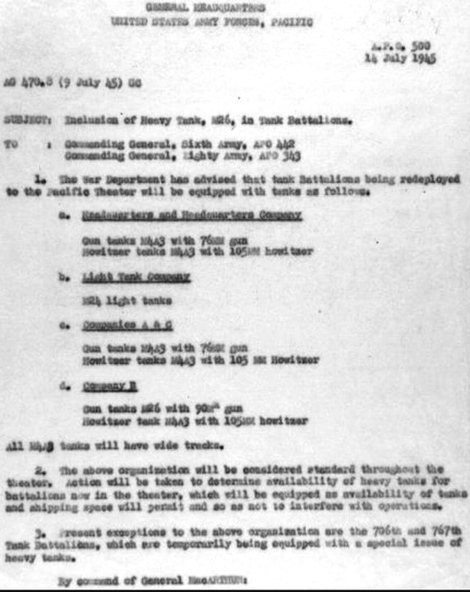
While no 76mm Shermans, (or
M26s for that matter) were used in combat in the Pacific Theater, plans for the
Invasion of Japan envisioned the employment of 12 or more Tank Battalions,
equipped with the most modern AFVs. It was intended to outfit each Army Battalion with M26s, M4A3(76)s and
M4A3(105)s with HVSS, and M24 Light Tanks as shown in
the proposed July 1945 TO&E reproduced above. The Marines continued to
prefer the 75mm Sherman over the 76, and their plans included the use of
M4A3(75)s and M4A3(105)s with HVSS in the 3 Battalions slated to take part. Documentation courtesy
of Trent Telenko. For more information about the plans for the invasion of
Japan, see his “Secrets of the Pacific Warfare Board -- Pershing Tanks for
Operation Olympic.” http://chicagoboyz.net/archives/43946.html

M4A3(76) production was
terminated in April 1945 after 4542 units had been built. Officially, 1925 were
VVSS models and 2617 were HVSS. The planners had to assume that there would be
an invasion of Japan, and that the campaign might drag on for many months or
even years. To this end, Fisher Body and Chrysler were contracted to produce
7500 M26s to replace the Sherman as the Army's main battle tank. As it turned
out, M26 production was terminated in October 1945, after only 2202 had been
manufactured. With the onset of the Cold
War, it was realized that this number would be insufficient to meet the Army's
requirements, and thus the M4A3(76)HVSS was continued in service as an
acceptable substitute for the M26. The photo above
shows the M24, the M4A3(76)HVSS and the M26 - "the three primary tanks of
the Army" at Camp Hood, Texas in October, 1947.
PAGE 1/2
Go to page 2
HOME






















































